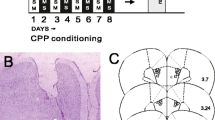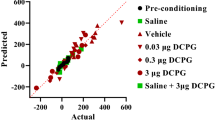Abstract
The conditioned place preference paradigm was used to investigate the neurochemical and neuroanatomical substrates which mediate the rewarding properties of diazepam. The results confirmed that diazepam (1 and 2.5 mg/kg, IP) produced place preference for a distinctive environment that had previously been paired with injections of the drug. Pretreatment with haloperidol (0.1 mg/kg) antagonised the place preference induced by diazepam (1 mg/kg). Pretreatment with domperidone (2 mg/kg) failed to influence this effect of diazepam. Haloperidol (0.1 mg/kg) and domperidone (2 mg/kg) alone did not produce place aversion. In separate experiments the diazepam-induced place preference was examined in rats having 6-hydroxydopamine (6-OHDA) lesions of the nucleus accumbens. These animals did not show preference for the compartment associated with diazepam. Depletion of central noradrenaline produced by systemic injections of DSP4 did not affect diazepam-induced place preference conditioning. These findings suggest that dopamine-containing neurons of the mesolimbic system are a component of the neural circuitry that mediates the reinforcing properties of diazepam.
Similar content being viewed by others
References
Andén NE, Butcher SG, Corrodi H, Fuxe K, Ungerstedt U (1970) Receptor activity and turnover of dopamine and noradrenaline after neuroleptics. Eur J Pharmacol 11:303–311
Anton A, Sayre D (1962) A study of the factors affecting the aluminum oxide trihydroxyindole procedure for the analysis of catecholamines. J Pharmacol Exp Ther 138:360–375
Bozarth MA (1983) Opiate reward mechanisms mapped by intracranial self-administration. In: Smith JE, Lane JD (eds) The neurobiology of opiate reward process. Elsevier Biomedical, pp 331–359
Cox TC, Jacobs MR, LeBlanc AE, Marshamn JA (1983) Drugs and Drug Abuse. A reference text. Alcoholism and Drug Addiction Research Foundation, Toronto, pp 43–82
Duka TH, Wüster M, Herz A (1979) Rapid changes in enkephalin levels in rat striatum and hypothalamus induced by diazepam. Naunyn-Schmiedeberg's Arch Pharmacol 309:1–5
Ettenberg A, Pettit HO, Bloom FE, Koob GF (1982) Heroin and cocaine intravenous self-administration in rats: mediation by separate neural systems. Psychopharmacology 78:204–209
Farah JM, Demarest KT, Moore KE (1983) A comparison of domperidone and haloperidol effects on different dopaminergic neurons in the rat brain. Life Sci 33:1561–1566
Fibiger HC (1978) Drugs and reinforcement mechanisms: A critical review of the catecholamine theory. Annu Rev Pharmacol Toxicol 18:37–56
File SE (1986) Aversive and appetitive properties of anxiogenic and anxiolytic agents. Behav Brain Res 21:189–194
Fuxe K, Agnati LF, Bolme P, Hökfelt T, Lidbrink P, Ljungdahl A, de la Mora MP, Ögren SO (1975) The possible involvement of GABA mechanisms in the action of benzodiazepines on central catecholamine neurons. In: Costa E, Greengard P (eds) Advances in biochemical psychopharmacology: Mechanism of action of benzodiazepines, 14. Raven, New York, pp 45–61
Griffiths RR, Ator NA (1982) Benzodiazepine self-administration in animals and humans: A comprehensive review. In: Benzodiazepines, Monograph Series, Health and Human Services Publication, US Government Printing Office, Washington, DC
Harsing LG Jr, Yang H-YT, Costa E (1982) Evidence for a γ-amino-butyric acid (GABA) mediation in the benzodiazepine inhibition of the release of met5-enkephalin elicited by depolarization. J Pharmacol Exp Ther 220:616–620
Herberg LJ, Williams SF (1983) Anti-conflict and depressant effects by GABA agonists and antagonists, benzodiazepines and non-GABAergic anticonvulsants on self stimulation and locomotor activity. Pharmacol Biochem Behav 19:625–633
Ishiko J, Inagaki C, Takaori S (1983) Effects of diazepam, nitrazepam and brotizolam on dopamine turnover in the olfactory tubercle, nucleus accumbens and caudate nucleus of rats. Jpn J Pharmacol 33:7006–7008
Jaim-Etcheverry G, Zieher LM (1980) DSP-4: a novel compound with neurotoxic effects on noradrenergic neurons of adult and developing rats. Brain Res 188:513–523
Keller HH, Schaffner R, Haefely W (1976) Interaction of benzodiazepines with neuroleptics at central DA neurons. Naunyn-Schmiedeberg's Arch Pharmacol 294:1–17
König JFR, Klippel RA (1970) The rat brain. A stereotaxic atlas of the forebrain and lower parts of the brain stem. Krieger, Huntington, New York
Laduron PM, Leysen JE (1979) Domperidone, a specific in vitro dopamine antagonist, devoid of in vivo central dopaminergic activity. Biochem Pharmacol 28:2161–2165
Mitchell PR, Martin IL (1980) Facilitation of striatal potassium-induced dopamine release: Novel structural requirements for a presynaptic action of benzodiazepines. Neuropharmacology 19:147–150
Möhler H, Okada T, Heitz PH, Ulrich J (1978) Biochemical identification of the site of action of benzodiazepines in human brain by3H-diazepam binding. Life Sci 22:985–996
Nazzaro J, Gardner EL (1980) GABA-antagonism lowers self-stimulation thresholds in the ventral tegmental area. Brain Res 189:279–283
Nutt D (1986) Benzodiazepine dependence in the clinic: reason for anxiety? TIPS 7:457–460
Phillips AG, LePiane FG, Fibiger HC (1983) Dopaminergic mediation of reward produced by direct injection of enkephalin into the ventral tegmental area of the rat. Life Sci 33:2505–2511
Porino LJ, Coons EE (1980) Effects of GABA receptor blockade on stimulation-induced feeding and self-stimulation. Pharmacol Biochem Behav 12:125–130
Rastogi RB, Agarwal RA, Lapierre YD, Singhal RL (1977) Effects of acute diazepam and clobazam on spontaneous locomotor activity and central amine metabolism in rats. Eur J Pharmacol 43:91–98
Redmond DE Jr (1979) New and old evidence for the involvement of brain norepinephrine system in anxiety. In: Fann WE (ed) The pharmacology and treatment of anxiety. Spectrum, New York, pp 153–203
Roberts DCS, Koob GF, Klonoff P, Fibiger HC (1980) Extinction and recovery of cocaine self-administration following 6-hydroxydopamine lesions of the nucleus accumbens. Pharmacol Biochem Behav 12:781–787
Schuster CR, Thompson T (1968) Self-administration of and behavioural dependence on drugs. Annu Rev Pharmacol 9:483–502
Speth RC, Guidotti A, Yamamura HI (1981) The pharmacology of benzodiazepines. In: Palmer GC (ed) Neuropharmacology of central nervous system and behavioural disorders. Academic, New York, pp 243–283
Spyraki C, Fibiger HC (1982) DSP-4 and 6-hydroxydopamine: comparative biochemical and histological observations. Neuroscience, [Suppl] 7: S200
Spyraki C, Fibiger HC, Phillips AG (1982a) Dopaminergic substrates of amphetamine-induced place preference conditioning. Brain Res 253:185–193
Spyraki C, Fibiger HC, Phillips AG (1982b) Cocaine-induced place preference conditioning: Lack of effects of neuroleptics and 6-hydroxydopamine lesions. Brain Res 253:195–203
Spyraki C, Fibiger HC, Phillips AG (1982c) Attenuation by haloperidol of place preference conditioning using food reinforcement. Psychopharmacology 77:379–382
Spyraki C, Fibiger HC, Phillips AG (1983) Attenuation of heroin reward in rats by disruption of the mesolimbic dopamine system. Psychopharmacology 79:278–283
Spyraki C, Kazandjian A, Varonos D (1985) Diazepam-induced place preference conditioning: appetitive and antiaversive properties. Psychopharmacology 87:225–232
Stein L, Belluzi JD, Wise D (1977) Benzodiazepines: behavioral and neurochemical mechanisms. Am J Psychiatry 134:665–669
Vachon L, Kitsikis A, Roberge AG (1984) Chlordiazepoxide, GoNogo successive discrimination and brain biogenic amines in cats. Pharmacol Biochem Behav 20:9–22
Wise RA (1978) Catecholamine theories of reward: A critical review. Brain Res 152:315–347
Wise RA, Bozarth MA (1982) Action of drugs of abuse on brain reward systems: An update with specific attention to opiates. Pharmacol Biochem Behav 17:239–243
Wise RA, Bozarth MA (1984) Brain reward circuitry: Four circuit elements “wired” in apparent series. Brain Res Bull 12:203–208
Author information
Authors and Affiliations
Rights and permissions
About this article
Cite this article
Spyraki, C., Fibiger, H.C. A role for the mesolimbic dopamine system in the reinforcing properties of diazepam. Psychopharmacology 94, 133–137 (1988). https://doi.org/10.1007/BF00735894
Received:
Revised:
Issue Date:
DOI: https://doi.org/10.1007/BF00735894




